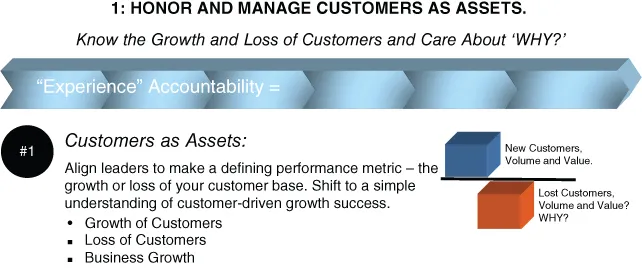
Chief Customer Officer 2.0
How to Build Your Customer-Driven Growth Engine
Jeanne Bliss
- English
- ePUB (handyfreundlich)
- Über iOS und Android verfügbar
Chief Customer Officer 2.0
How to Build Your Customer-Driven Growth Engine
Jeanne Bliss
Über dieses Buch
A Customer Experience Roadmap to Transform Your Business and Culture
Chief Customer Officer 2.0 will give you a proven framework that has launched and advanced the customer experience transformation in businesses in every vertical around the world.
And it will take years off your learning curve.
Written by Jeanne Bliss, worldwide authority on customer experience, and preeminent thought leader on the role of the Customer Leadership Executive (such as Chief Customer Officer, Vice President of Customer Experience, etc.) this book follows the five-competency model she uses to coach the C-Suite and Chief Customer Officers.
1. Manage and Honor Customers as Assets
2. Align Around Experience
3. Build a Customer Listening Path
4. Proactive Experience Reliability and Innovation
5. One Company Accountability, Leadership & Decision Making
Chief Customer Officer 2.0 will get you into action quickly with a united leadership team, and will shift your business intent to earning the right to growth by improving customers' lives. Jeanne Bliss fearlessly shares her tools and leadership 'recipe cards' for leading and enabling your business transformation. And she provides practical guidance on how embed the five competencies into how your company develops products, goes to market, enables and rewards people, and conducts annual planning.
Including over forty accounts of actions by Customer Leadership Executives around the world, this is the book you have been waiting for that tells it like it is and gives you the framework to build your customer-driven growth engine.
Jeanne Bliss pioneered the Customer Leadership Executive position, holding the role for twenty years at Lands' End, Allstate, Coldwell Banker, Mazda and Microsoft Corporations. Since 2002 she has led CustomerBliss, a preeminent customer experience transformation company where she helps companies achieve customer-driven growth. She is a worldwide keynote speaker, and sought frequently by major media for her point of view. Jeanne is the co-founder of the Customer Experience Professionals Association, established to advance the worldwide discipline of customer experience and customer experience practitioners. She is also the best-selling author of Chief Customer Officer: Getting Past Lip Service to Passionate Action (2006), and I Love You More than My Dog: Five Decisions to Drive Extreme Customer Loyalty in Good Times and Bad (2011).
Häufig gestellte Fragen
Information
Chapter 1
Chief Customer Officer Role Clarity

- A leap of faith.
- Expensive.
- Deterrents to the “real” work.
The Five Customer Leadership Competencies
- They establish the connection to business growth. The five competencies elevate customer experience efforts from getting a score to ‘earning the right’ to growth.
- You build them at your own pace, with actions that are most potent for your culture, your leaders, and the company's ability to take on the work within each competency.
- They build an engine analogous to the familiar process of product development, with distinguishable steps and metrics and performance requirements. These five competencies provide an equal discipline for focused customer experience development.
- They drive a one-company focus on customer experiences by uniting leaders in investing in the most impactful priorities. Competency five, for example, builds a monthly process (called a customer room) to step people into the shoes of the customer, uniting the company to focus on a few critical actions rather than having every silo choosing many tactics separately from one another.
- They specify actions that demystify the role of the customer leadership executive (CCO, CXO, etc.). The role becomes clear, as architect and facilitator of the engine, uniting leaders to make decisions that improve customers' lives and lead to business growth.
- Action Lab: Tools and templates to immediately put into use.
- My Rock, My Story: CCO stories on how they united leadership, worked through challenges, and achieved success.
